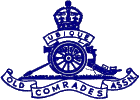 |
A Short History of the
|
prev index next | ||||||||||||||||||
|
The Defence Act of 31 July 1886 severed the Armed Constabulary from the New Zealand Constabulary, which became the New Zealand Police. AC Field Force and Reserve men now had the option of joining the Police or the 'New Zealand Permanent Militia', which came into effect on 1 September 1886. Why the politicians called the new force a 'militia' is difficult to understand; obviously it was a misnomer for members of a militia were (and still are) troops called out for service on a compulsory basis, while those joining the new force were all volunteers. Perhaps the politicians did not know the difference. When formed the NZPM establishment (all ranks) was as follows:
On the original roll WOs, NCOs, and Men were allotted regimental numbers from 1 to 328, Officers not being numbered in those days. RNZA regimental numbers followed on from this series, ending in 1996 in 1940, at which time recruitment of regular soldiers ceased until after World War 2. All Regular Force personnel were then allotted army numbers, Officers included. Meagre as it was by standards then prevailing in other colonies, the NZPM establishment was short-lived; in 1888 '... having found retrenchment necessary ...' the Government drastically reduced it. Field Artillery, Engineers, and Rifles disappeared, the men being absorbed into the Garrison Artillery or Torpedo Corps if suitably qualified, or sacked. In 1892 the establishment stood at 204 all ranks, 142 in the Artillery, 62 in the Torpedo Corps. Another reorganisation took place in 1897, by which time strength had grown to 270. The Force was divided into two companies designated: No 1 Service Company: Garrison Artillery Branch (191 all ranks) The two branches were also referred to as the 'New Zealand Permanent Artillery' and the 'New Zealand Torpedo Corps', respectively. The title 'New Zealand Permanent Militia', which had never been popular with the military authorities, was now dropped, and the two companies together were henceforth called 'The New Zealand Permanent Force.' Men of No. 2 Company were at first wrongly called Gunners, but about a year later were re-named Sappers. Despite the parting of the ways brought about by the Act of 1886, ties between Police and Permanent Force remained close. Gunners were from time to time called upon not only to reinforce Police for crowd control at race meetings, etc, but also for ordinary beat work, especially during industrial troubles. Policemen and Soldiers worked well together, for many of the former had been members of the NZAC or NZPM, they trained at the same Depot, and most knew one another. It was still possible for men to transfer directly from the Permanent Force to the Police or Prisons Service or vice versa, although transfers were usually one-way owing to the better pay and conditions prevailing in the last two services. Indeed there were so many Policemen who had trained as Gunners that the authorities at one time proposed refresher courses in gunnery be run for Policemen so they could reinforce coastal battery personnel in an emergency. One such course attended by 100 Policemen was actually held in 1895, but was not repeated, probably because Officers of both forces realised the idea was basically unsound. Doubtless the course was an excellent reunion! On 12 October 1899 the South African war broke out. No Permanent Force NCO's and Men were actually seconded overseas, because the Force, which had barely sufficient men to fulfil its peace-time commitments, was in addition required to instruct the 10 Contingents of Mounted Riflemen who left New Zealand. Four or five Officers were seconded to Royal Artillery units for experience, but the few rank and file who got away went as Mounted Riflemen. Two New Zealand batteries did take part in the conflict; one, equipped with Hotchkiss machine guns supplied by the Elswick Ordnance Co., left the country with the Second Contingent, but was short-lived as the equipment was too heavy for the horses, and could be outranged by Boer Mausers. The other, a field battery trained and equipped by the RA in South Africa, was manned by Mounted Riflemen 'converted' to Gunners for the purpose. On 15 October 1902 King Edward VII granted the title 'Royal' to both companies of the New Zealand Permanent Force. No 1 Company, which took precedence, was designated 'Royal New Zealand Artillery', while No 2 Company became 'Royal New Zealand Engineers'. The RNZE eventually developed into a coast artillery electric light (searchlight) section, and in 1907 was absorbed into the RNZA, leaving: | ||||||||||||||||||||
| ||||||||||||||||||||
|
to which a small clerical section was added. Included in the overall establishment were twelve Artificers RNZA, inevitably dubbed 'the dirty dozen'! This organisation lasted until 1926, when distinctions between sections were abolished, personnel being detailed for duties as required. In the same year RNZA 'detachments' at the various stations became 'cadres.' On 7 January 1907 occurred the first meeting of the Council of Defence, which took the place of the previous administration and control of the Forces. It was charged with advising the Minister on all matters of defence. Over the next two or three years the Council found many shortcomings, particularly with the Volunteers, few units of which '... they could honestly call efficient ...'. Drastic steps were proposed to rectify the situation, and some rude shocks were in the offing - both for the Volunteers and the Permanent Force. .../A New Order previous | index | next | History index | Home | ||||||||||||||||||||